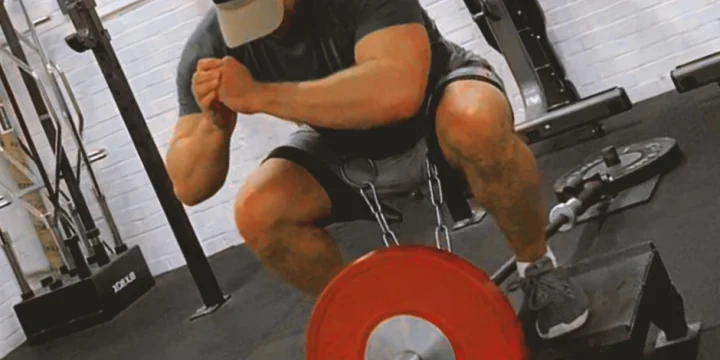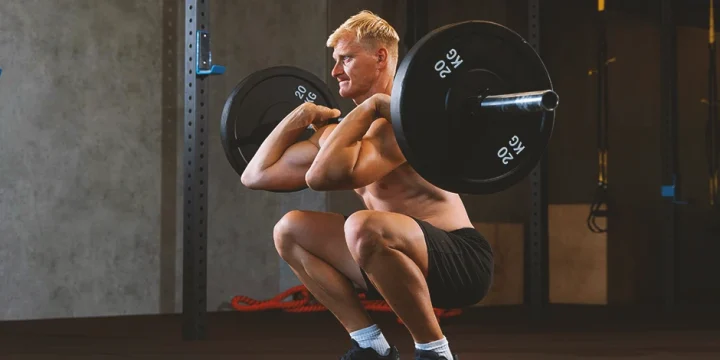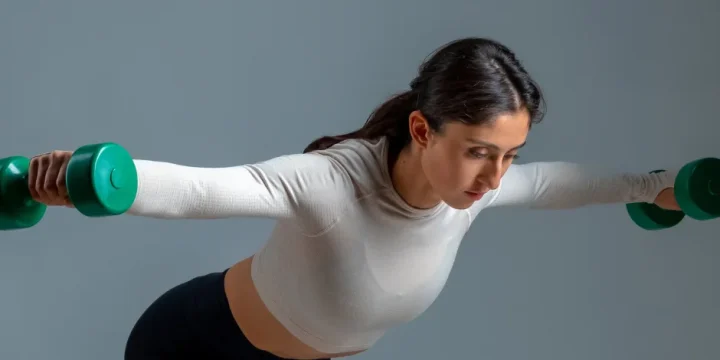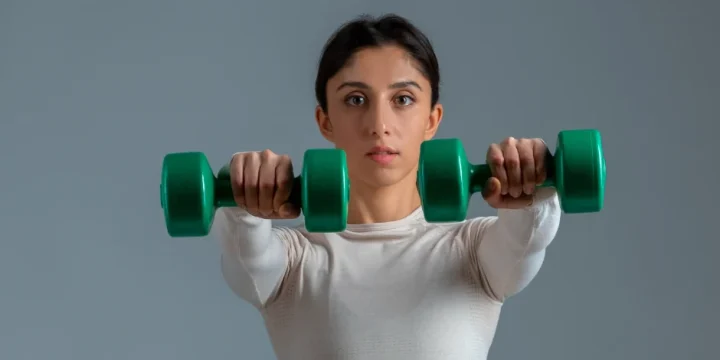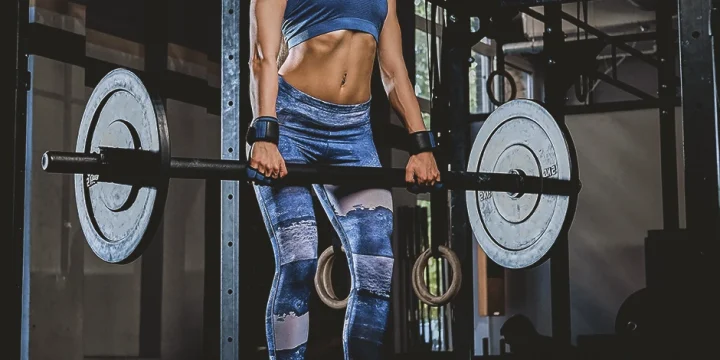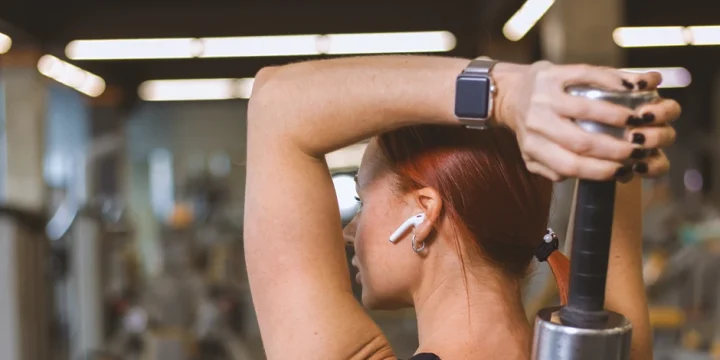Our investigation demonstrated that the dumbbell front squat is a highly effective exercise that can boost your leg growth and overall fitness.
This training strengthens your lower body's core muscle groups, enhances stability, and promotes better posture when performed correctly.
And in my experience, despite its apparent simplicity, the dumbbell front squat offers a wealth of benefits that help you progress in your fitness journey, making it an excellent addition to any workout routine.
Quick Summary
- To perform a dumbbell front squat, stand with feet shoulder-width apart, hold dumbbells at shoulder height, squat down while keeping the back straight, and then return to the standing position.
- The dumbbell front squat is an effective exercise for enhancing leg growth and overall fitness, focusing on strengthening the lower body's core muscle groups.
- The dumbbell front squat not only targets the quadriceps, glutes, and core but also engages the upper back and shoulders, making it a comprehensive exercise for whole-body conditioning.
- In my experience, the dumbbell front squat, despite its simplicity, offers significant benefits for fitness progression, making it an excellent addition to any workout routine.
Proper Form of the Dumbbell Front Squat

Having proper form while performing dumbbell front squats — even a squat variation — is essential.
Consider the following while performing:
- Initiate the movement by standing with your feet shoulder-width apart, holding the dumbbells at shoulder height.
- Engage your core and keep the spine neutral. Take a deep breath.
- Start the motion and ensure your thighs are parallel to the floor when beginning the squat. Breathe out as you lower your body.
- Push through your heels to ascend and keep the dumbbells steady at shoulder height throughout the movement.
Mistakes To Avoid When Performing Dumbbell Front Squats
When performing dumbbell front squats, it's crucial to avoid common mistakes to ensure effectiveness and prevent injury. Here are four key mistakes to watch out for:
- Incorrect posture: Avoid rounding your back or leaning too far forward. Maintain a straight, neutral spine throughout the movement.
- Improper foot positioning: Your feet should be shoulder-width apart. Placing them too close or too wide can lead to imbalance and strain.
- Insufficient depth: Not squatting deep enough reduces the exercise's effectiveness. Aim to lower your hips at least parallel to your knees, as long as there's no discomfort.
- Rapid movements: Avoid rushing the exercise. Perform both the lowering and rising phases in a controlled manner to engage the muscles properly and reduce the risk of injury.
What is the Dumbbell Front Squat Exercise?
The dumbbell front squat is a dynamic, compound exercise that activates muscles simultaneously.
To engage in a functional, full-body movement, you must hold a pair of dumbbells at shoulder height in an overhead squat motion.
It cultivates strength in the lower body, enhances balance and flexibility, and fortifies core stability, making the dumbbell front squat a fundamental addition to any fitness regimen.
Muscles Worked During Dumbbell Front Squats
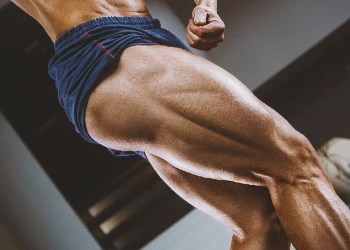
The dumbbell front squat is a potent tool for whole-body conditioning.
It focuses on training the quadriceps, hamstrings, and glutes but also engages with the core, upper back, and shoulders.
This exercise is not just a lower-body developer but an integral component of holistic strength and conditioning.
Benefits of Doing Dumbbell Front Squat Training
As a multi-joint movement, the benefits of working out with the dumbbell front squat are:
- Enhances lower body and upright torso strength
- Fosters better posture
- Increases core stability
- This leads to a higher calorie burn
- Needs minimal equipment to perform
Dumbbell Front Squat Variations

The dumbbell front squat is a flexible exercise. This means that – like the barbell front squats – it has variations to spice up your workout regime. According to ResearchGate, each exercise targets unique muscle groups and skill levels [1].
Dumbbell Goblet Squats
I often introduce my clients to goblet squats, guiding them to hold a single dumbbell with both hands at chest level to start.
It promotes balance, proper posture and intensifies core engagement due to the front-loaded weight.
As noted in a study by the National Institute of Health, its simplicity makes it an optimal starting point for beginners while still challenging for experts [2].
If you're looking for a greater challenge, you can try it's variation the crush grip goblet squat.
Heels-Elevated Dumbbell Front Squats
This squat variation requires your heels to be elevated on a small platform, such as a weight plate or step.
The elevation alters muscle engagement, emphasizing the quadriceps and other leg muscles.
It allows you to start from a deep squat position to its inclined nature, enhancing mobility and flexibility in the lower body.
Dumbbell Zercher Squat

The dumbbell zercher squat is an advanced variant, requiring you to cradle the dumbbell in the crook of your elbows.
This variation increases the upper body and core demand, transforming the exercise into a robust, full-body workout.
Traditional Dumbbell Squat
The traditional dumbbell squat involves holding a dumbbell in each hand at your sides.
This variant focuses substantially on the lower body, particularly activating the glutes and hamstrings, making it a staple in most leg training workout routines.
As ResearchGate instructs, ensure you use lightweight and have the chest lifted if you’re a beginner [3].
Intense Training Sessions with Dumbbell Front Squats

I've found integrating dumbbell front squats into my clients' intense training regimens accelerates their progress towards health and fitness goals due to its versatility.
Here's an intense 4-day training routine featuring dumbbell front squats for those seeking to elevate their workouts:
Day 1 - Strength Focused
- Warm-up: Light cardio for 10 minutes
- Dumbbell Front Squats: 4 sets of 6 reps with heavy weight
- Dumbbell Lunges: 3 sets of 8 reps per leg
- Core exercises: Planks, Russian twists
- Cool down: Stretching
Day 2 - Endurance Focused
- Warm-up: Light cardio for 10 minutes
- Dumbbell Front Squats: 3 sets of 15 reps with moderate weight. You can try a variation with the front rack position
- Dumbbell Step-Ups: 3 sets of 12 reps per leg
- Core exercises: Leg raises, Bicycle crunches
- Cool down: Stretching
Day 3 - Power Focused
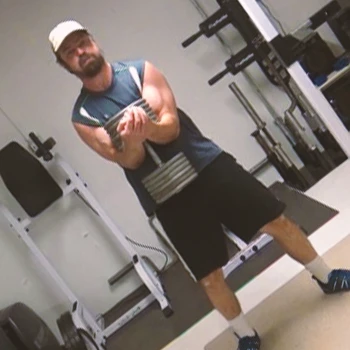
- Warm-up: Light cardio for 10 minutes
- Dumbbell Front Squats: 5 sets of 5 reps with heavy weight, focusing on explosive movement
- Box Jumps: 3 sets of 10 reps
- Core exercises: Mountain climbers, Flutter kicks
- Cool down: Stretching
Day 4 - Flexibility and Recovery
- Light cardio for 15 minutes
- Stretching: Focus on the legs and lower back
- Yoga or Pilates: Incorporate moves that enhance flexibility and core strength
- Hydrate and rest
Adding More Weight to Dumbbell Front Squats
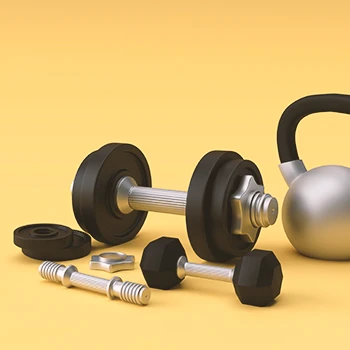
You can use heavier dumbbells to add more weight to your squats.
I recommend having a good standing position and controlling the previous load before increasing it to avoid squat mistakes.
It will be challenging for your muscles but will lead you to gain more strength and muscle growth.
Based on my firsthand experience, if you can’t control the weights, you should notice your form faltering. This is a sign to reduce weight or take longer rests.
Go for a deeper squat form with lightweight instead of increasing loads.
"Squats not only build muscle and strength, but they also increase flexibility, improve balance, and train your body to work as a coordinated system, as opposed to a collection of individual parts. This makes them an essential part of any well-rounded fitness program."
- Mark Rippetoe
FAQs
Is the Barbell Front Squat Better than Dumbbell Front Squats?
No, the barbell squat isn't better than the dumbbell front squat because each exercise offers unique benefits and challenges. Dumbbell variants enhance the range of motion and stability, while barbell variants allow for heavier loads, boosting strength and muscle mass.
Is Dumbbell Front Squat Only for Intermediate and Advanced Lifters?
No, the dumbbell front squat isn't only for intermediate and advanced lifters. It's a versatile exercise suitable for all fitness levels.
Beginners can benefit from its emphasis on an upright position and stability, while experienced lifters can challenge themselves with increased weight or complex variations. It's adaptable to individual strengths and skill levels.
What Can I Do to Improve My Dumbbell Front Squat Technique?
You can improve your dumbbell front squat technique by focusing on form. Perform regularly and add mobility exercises into your routine. This approach helps you to maintain a straight back, keep your chest up, and ensure your knees track over your toes.
Hence enhancing your athletic performance with traditional and front-loaded variations.
Reference:
- https://www.researchgate.net/publication/271794654
- https://www.ncbi.nlm.nih.gov/pmc/articles/PMC9311947/
- https://www.researchgate.net/publication/277965730
About The Author
You May Also Like
